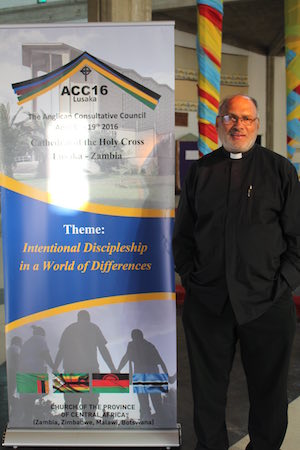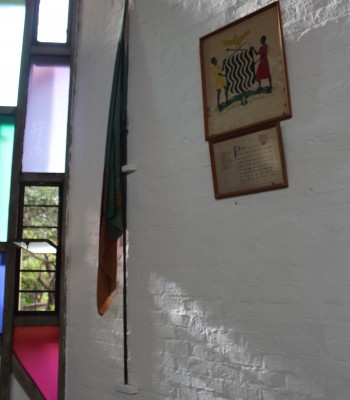LUSAKA, ZAMBIA—April 12—The 16th meeting of the Anglican Consultative Council (ACC), is taking place at a fractious time in the Anglican Communion. But the Cathedral of the Holy Cross, in which the meeting is being held, has seen much worse, and has long been a venue for high-stakes meetings among groups in conflict.

At the ACC’s opening Eucharist on Sunday, Zambian President Edgar Lungu told a crowd of thousands, “We cannot forget that among the numerous progressive activities achieved with the intervention of the church was Zambia’s return to multi-partism or plural politics in 1991. It goes down in history that this venue, the Cathedral of the Holy Cross, provided the much-needed conducive platform and atmosphere for that purpose. A seemingly difficult transition was made possible. We achieved what has become a model for Africa in many respects.”
The cathedral’s role as a convener of significant political meetings was already well-established by 1991, when the Movement for Multiparty Democracy formed to oppose the the United National Independence Party and the 27-year rule of Zambia’s first president, Kenneth Kaunda, the Very Rev. Charlie Thomas, dean of Lusaka, said in an interview on Sunday.
“In 1964, the first independence thanksgiving service was held in the cathedral,” Thomas said. “The flag from that independence service is still here on the wall of the cathedral. For you Episcopalians, I think a comparison would be the Washington Cathedral.”
“From then on, there were certain meetings that took place here pre-independence,” Thomas said. “Then things happened here in the political world, and at one point, President Kaunda’s one party state was being challenged. And the challenge came head-on between President Kaunda and the multiparty group. It was becoming ugly, and I think the old uniparty was not ready to give up.”

Three groups of church leaders—the Evangelical Fellowship of Zambia, the Council of Churches in Zambia, an affiliate of the World Council of Churches, and the Zambia Episcopal Conference, the Roman Catholic group—convened a meeting at the Cathedral of the Holy Cross that included President Kaunda and his advisors and Frederick Chiluba, a labor leader who led the opposition party and became the country’s second president in the 1996 general elections.
“They came here to the cathedral, and the then-bishop of the cathedral, Bishop Stephen Mumba, chaired that meeting,” Thomas said. “And through that meeting was borne the Third Republic and multi-party democracy.”
The 1996 elections were pivotal to Zambia, says Thomas. “Then the economy changed from a restrictive economy to a liberal economy. It changed the direction of the country. Today the reasonable affluence [in Zambia] can be attributed to that change of philosophy.”
Today the World Bank reports that Zambia is a “lower middle income” nation with a per capita income of $1680, twice that of Zimbabwe, the nation to the south that shares much of Zambia’s colonial history but has endured one party rule since 1980.
The initiative to build the cathedral began in the 1950s when the British administrators of the colony wanted Lusaka to have the status of a city. Attaining such status required a cathedral. The British royal family, wealthy industrialists, and ordinary colonists responded to the fundraising appeal.
“I’ve met ladies and gentlemen who had even migrated back to England who used to raise money for this cathedral, who used to sell cakes,” Thomas said. “It went from one level on the corporate world to individuals who could claim a brick. So there was a very concerted effort to build this cathedral. A structure like this in the 1950s was quite a challenge.”
The roof of the cathedral is copper, which is Zambia’s largest export and a mainstay of its economy.
Today every special occasion and national occasion is celebrated at the cathedral, says Thomas. And the ACC meeting may not even be the most contentious gathering that the cathedral has hosted this month. Zambia will hold national elections in August, and violence has already broken out. Two weeks ago, Thomas says, “when these elections were hotting up, there was another cry from the mother bodies that they should sit down and talk.”
Lungu called a meeting that was facilitated by the three church “Mother bodies,” and 18 of the country’s 23 political parties attended. “The people in conflict were there, and they did dialogue and there was a lot of exchange.”
“It made an immediate difference,” Thomas says. “The president himself called out for maximum restraint in his own party.”
He traces the cathedral’s power back to David Livingstone, the white missionary who crossed the Zambezi River at Victoria Falls in 1855 and claimed the region for Christianity.
“There is a certain thing about this nation,” Thomas says. “It can always go to the brink of conflict and walk away, it can go to the brink of disaster and then slowly get rescued. There is a hand of God on this nation, and the spirituality of the people of this nation is tied to that.”